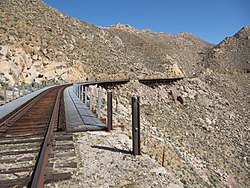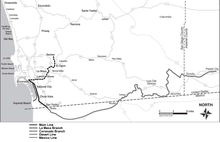San Diego and Arizona Eastern Railway
The San Diego and Arizona Eastern Railway Company (reporting mark SDAE) is a short-line American railroad founded in 1932 as the successor to the San Diego and Arizona Railway (SD&A), which was founded in 1906 by entrepreneur John D. Spreckels. Dubbed "The Impossible Railroad" by many engineers of its day due to the immense logistical challenges involved, the line was established in part to provide San Diego with a direct rail link to the east by connecting with the Southern Pacific Railroad lines in El Centro, California. Since 1979, the company has been owned by the San Diego Metropolitan Transit Development Board and its successor, the San Diego Metropolitan Transit System.
 | |||
 Carrizo Gorge trestle | |||
| Overview | |||
|---|---|---|---|
| Current operator | San Diego and Imperial Valley Railroad | ||
| Parent company |
| ||
| Headquarters | James R. Mills Building 1255 Imperial Avenue San Diego, California | ||
| Reporting mark | SDAE | ||
| Locale | California and Mexico | ||
| Dates of operation | 1932–present | ||
| Predecessor | San Diego and Arizona Railway | ||
| Technical | |||
| Track gauge | 4 ft 8+1⁄2 in (1,435 mm) standard gauge | ||
| |||
Network
editAt its peak, the SD&A's operated a 146.4-mile (235.6 km) stretching from San Diego to El Centro. Today, the SD&AE operates approximately 108 miles (174 km) of the original SD&A system, across four segments:[1]
- Main Line: Runs 15.5 miles (24.9 km) from downtown San Diego south to San Ysidro. Also used by the San Diego Trolley's Blue Line.
- La Mesa Branch: Runs 16.1 miles (25.9 km) east to the city of El Cajon. Also used by the San Diego Trolley's Orange Line.
- Coronado Branch (currently unused): Splits from the Main Line in National City and runs 7.2 miles (11.6 km) south to Imperial Beach.
- Desert Line (unused since 2008): Runs 69.9 miles (112.5 km) from the Mexico–United States border near Tecate to Plaster City.[2]
History
editThe San Diego and Arizona Eastern Railway Company traces its origins back to December 14, 1906, when entrepreneur John D. Spreckels announced he would form the San Diego and Arizona (SD&A) Railway Company and build a railroad to provide San Diego with a direct rail link to the east by connecting with the Southern Pacific (SP) lines in El Centro, California. Spreckels had an agreement with SP to silently fund the project. Groundbreaking for the line took place on September 7, 1907.[1][3][4]
The SD&A reached an agreement with the Mexican Government in 1909 to route the tracks over the border. As part of the agreement, the SD&A is ordered to form the Tijuana and Tecate Railway, which will construct and hold a 99-year lease on the 44-mile (70.81 km) Mexican rail segment.[1]
Construction proved extremely challenging. The line was called "The Impossible Railroad" by many engineers of its day due to the immense logistical challenges involved. In Mexico, revolutionaries mount several attacks on SD&A construction crews to conscript soldiers, take supplies, and cut telephone wires. On the U.S. side, the federal government seized control of all railroads in 1917 and stopped construction in an effort to conserve resources amid World War I. Construction was later allowed to resume on the grounds that the SD&A would serve military installations.[1]
Construction of the SD&A was completed on November 15, 1919, at a cost of $18 million (equivalent to $316 million in 2023).[3] However, operation of the line would also prove challenging. Rains washed away large amounts of trackage east of San Diego in 1926, 1927 and 1929, leading to financial troubles for the railroad. The most challenging year came in 1932 when floods, landslides, and fires closed three tunnels. Repairs would cost over $600,000 (equivalent to $13,399,000 in 2023). Spreckels had died in 1926 and his descendants no longer wanted to deal with the financial troubles of the railroad. So, in 1933, they sold their interests in the railroad to SP. Passenger service on the line ended on January 11, 1951, after years of continued declining patronage.[1] On May 20, 1970, SP relinquished its interest in the Tijuana and Tecate Railway to a Mexican national railway, Ferrocarril Sonora–Baja California.
On September 10, 1976 Hurricane Kathleen destroyed major sections of track and bridges on the line east of San Diego. SP wanted to abandon the railway, a request that was denied by the Interstate Commerce Commission in 1978.[5] The San Diego Metropolitan Transit Development Board (MTDB) stepped in and offered to buy the SD&AE for $18.1 million if SP fully repaired the line. The deal closed on August 20, 1979.
The purchase gave MTDB two sections of right-of-way that could be used for mass transit: the SD&AE Main Line from downtown San Diego to the San Ysidro Port of Entry, which would become the Blue Line of the San Diego Trolley and the SD&AE La Mesa Branch from downtown San Diego to El Cajon which would become the Orange Line.
As part of the deal, SP retained the section of the Desert Line between Plaster City and El Centro, and all tracks had to remain available for freight service. The board reached a deal with the San Diego and Imperial Valley Railroad on March 8, 1984, to continue to move railcars from the end of the Santa Fe Railway in downtown San Diego to industrial customers in the San Diego area or to the Mexico–United States border in San Ysidro. However, freight service between San Ysidro and Plaster City has struggled. Additional natural disasters and the bi-national nature of the line have closed the line several times since 1979, and the line has been unused since 2008.[6][7] In November 2021, the lease was cancelled for the most recent lessor of the line, the Baja California Railroad.[2]
References
edit- ^ a b c d e "San Diego & Arizona Eastern Railway Fact Sheet" (PDF). April 2013. Archived (PDF) from the original on November 8, 2021. Retrieved March 31, 2021.
- ^ a b Smith, James Emerson (November 13, 2021). "San Diego MTS determined to rehab 'Impossible Railroad' despite latest setback in the desert". The San Diego Union-Tribune. Archived from the original on November 15, 2021. Retrieved November 16, 2021.
- ^ a b "Background on the Infamous Goat Canyon Trestle Hike". The Last Adventurer. March 21, 2013. Archived from the original on December 21, 2023. Retrieved December 21, 2023.
- ^ Hanft, Robert M. (1984). San Diego & Arizona: The Impossible Railroad. Glendale, California: Trans-Anglo Books. ISBN 978-0-87046-071-5.
- ^ Gargrove, Dorian (September 10, 2014). "Crazy Train". San Diego Reader. Retrieved April 10, 2018.
- ^ Earl Spencer Pomeroy (October 21, 2008). American Far West in the Twentieth Century. Yale University Press. p. 462. ISBN 978-0-300-14267-9. Archived from the original on February 27, 2024. Retrieved April 11, 2018.
- ^ Smith, James Emerson (November 13, 2021). "San Diego MTS determined to rehab 'Impossible Railroad' despite latest setback in the desert". The San Diego Union-Tribune. Archived from the original on November 15, 2021. Retrieved November 16, 2021.
Further reading
edit- Copenhaver, George C. (May 6, 2007). "Geology of the San Diego & Arizona Eastern Railway, San Diego and Imperial Counties, California, U.S.A. and Baja California, Mexico". Cordlilleran Section – 103 Annual Meeting. The Geological Society of America.
External links
edit- Middlebrook Photographs of San Diego & Arizona Railway Locomotives MSS 438. Special Collections & Archives, UC San Diego Library.
